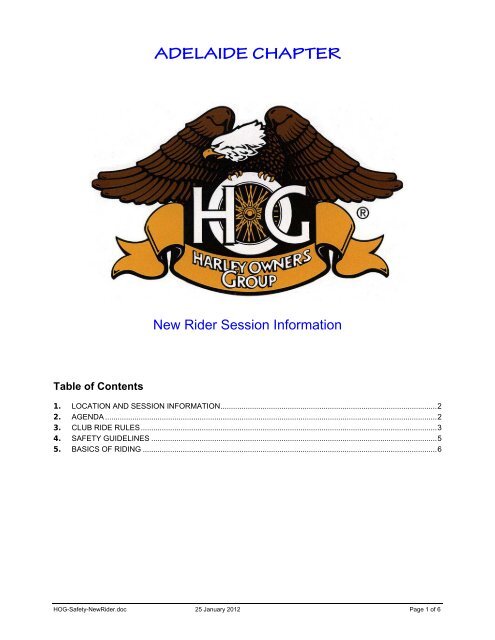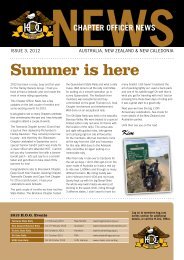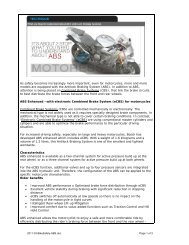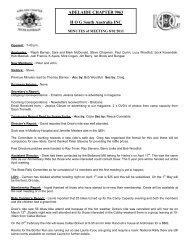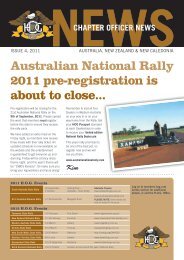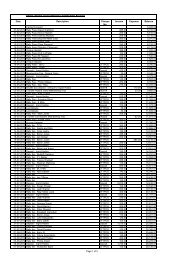ADELAIDE CHAPTER - Adelaide H.O.G.
ADELAIDE CHAPTER - Adelaide H.O.G.
ADELAIDE CHAPTER - Adelaide H.O.G.
Create successful ePaper yourself
Turn your PDF publications into a flip-book with our unique Google optimized e-Paper software.
<strong>ADELAIDE</strong> <strong>CHAPTER</strong><br />
New Rider Session Information<br />
Table of Contents<br />
1. LOCATION AND SESSION INFORMATION.......................................................................................................2<br />
2. AGENDA ..............................................................................................................................................................2<br />
3. CLUB RIDE RULES.............................................................................................................................................3<br />
4. SAFETY GUIDELINES ........................................................................................................................................5<br />
5. BASICS OF RIDING ............................................................................................................................................6<br />
HOG-Safety-NewRider.doc 25 January 2012 Page 1 of 6
1. LOCATION AND SESSION INFORMATION<br />
You must contact the Club Safety Officer if you want to attend.<br />
Greg Stevens 04 1164 9774 or email hungry1@adam.com.au<br />
Venue: The Greek On Halifax<br />
75/79 Halifax St, <strong>Adelaide</strong> SA 5000 (08) 8223 3336<br />
2. AGENDA<br />
Arrive at 8.30 to have breakfast or coffee before we start.<br />
Welcome<br />
Introduction of Members<br />
Brief Review of the Safety Guidelines<br />
Brief Review of the Ride Rules<br />
Basics of Riding-Reference Text, “Total Control” by Lee Parks, (I have some copies you<br />
can buy for $25).<br />
Go for a Ride, (the Hills are 10 minutes away)<br />
HOG-Safety-NewRider.doc 25 January 2012 Page 2 of 6
3. CLUB RIDE RULES<br />
Group Ride Rules<br />
1. Arrive at the departure point with a full tank<br />
2. Be ready to move off five minutes before the departure time.<br />
3. The Road Captain always leads the group and must not be overtaken. If two groups<br />
are officially designated, this rule of not overtaking applies to the Road Captain of the<br />
second group too.<br />
4. We ride in a staggered formation, not side by side, nor immediately behind the rider in<br />
front or in another riders blind spot, (in the case of following the rider in front, you<br />
should be able to see that rider’s face in their rear view mirrors.)<br />
5. Leave plenty of space between yourself and the rider in front. Pick a point that the<br />
rider in front passes, (say a line on the road or post and count one thousand and one,<br />
one thousand and two, one thousand and three). This provides for a three second<br />
buffer between you and the rider in front, (count to one thousand and four in wet<br />
weather). Remember on tight winding roads it is probable that riders take similar lines<br />
and a nose to tail effect results, therefore the previous stagger reduces dramatically<br />
and the three second or four second gap needs to be readdressed.<br />
6. You may change your position on the road within the group, but do it safely with a<br />
head check and indicate your intentions to the riders behind before doing so. Never<br />
pass on the left! Our safety when riding in a group depends on this.<br />
7. When overtaking a slower vehicle, provide a buffer zone for the riders following by<br />
maintaining your passing speed so as to provide for a gap between the pack and the<br />
passed vehicle whilst following riders complete the overtaking maneuver.<br />
8. We use only one lane of a multi-lane highway, keeping to the left whenever practical.<br />
The Road Captain chooses the lane. Always signal your intention to change lanes.<br />
9. Statutory speed limits are to be observed.<br />
10. When re-grouping spots, or designated fuel stops have been reached, stay in your<br />
position. Be prepared to move off when the last bike has refueled – don’t hold the<br />
group up – it is your responsibility to ensure you refuel and your refreshments are<br />
taken in the allotted time.<br />
11. All slower riders must ride at the rear of any group in fairness to other riders.<br />
12. In case of emergency stops or breakdowns, you must clearly indicate your intention to<br />
stop then get off the road as quickly as possible. The group must continue and the<br />
Tail End Charlie and/or Committee Member will also stop to assist.<br />
13. In respect of the safety of other members of the group and the public, no burn-outs,<br />
no donuts and no otherwise dangerous riding.<br />
14. Your motorbike must be roadworthy and mechanically ready for the ride. No bald<br />
tyres<br />
15. If you intend to leave the group during the ride, then inform the Ride Captain and the<br />
Tail End Charlie before doing so.<br />
These ride rules have been produced in the interests of safety and must be adhere3d<br />
to when participating in official HOG events.<br />
Corner Markers<br />
HOG-Safety-NewRider.doc 25 January 2012 Page 3 of 6
The reason for corner markers is to ensure the group stays on the ride route, and has<br />
plenty of warning of any deviation or clarification to the road ahead.<br />
If we all follow these basic guidelines, our system will not fail and all riders will arrive at the<br />
same destination.<br />
Guidelines:<br />
The next corner marker will be the rider following the Ride Captain.<br />
Leave TWICE the normal ride spacing to allow for safe stopping when indicated to do so.<br />
BE alert for the Ride Captain’s signal and to stop where indicated.<br />
The Ride Captain will raise his arm, giving the next rider time to prepare to stop. He will<br />
then point to the spot where he wants the corner marker positioned.<br />
STOP as close as possible to where the Ride Captain has indicated.<br />
Once safely positioned, indicate the direction of the ride by pointing and using your<br />
indicator.<br />
DO NOT remove helmet or other riding gear.<br />
Be ready to move on immediately when signaled to do so by the Tail End Charlie (TEC).<br />
The TEC’s will not stop.<br />
Do not move on until told to by the TEC or until it is Monday morning and you have to go<br />
to work …<br />
In the case of a major delay, the second TEC will stop, assess and inform others of the<br />
delay and advise the Corner Markers to move on.<br />
Corner Markers will join the group at the rear and only move back up to the front of the<br />
main group when it is safe to do so, or when everybody is stopped to regroup.<br />
SECOND BIKE BEHIND RIDE CAPTAIN:<br />
o The rider two back from Ride Captain will also leave twice the normal spacing<br />
between them and the rider in front<br />
DO NOT move up to fill the gap if rider in front and ride captain are in the same wheel<br />
track.<br />
Stay in your wheel track until the Ride Captain raises his arm to signal that you will be next<br />
Corner Marker down.<br />
When It Comes To Corner Marking, Ignorance Is No Excuse!<br />
Do not be afraid to get to the front of the pack and take your turn. Once you get to within 7<br />
or 8 bikes from the Ride Captain, you will be able to see how it all works and be ready for<br />
your turn.<br />
Tail End Charlie<br />
o Rides at the rear<br />
o Carries a club issued first aid kit<br />
o Is the only one to stop when a break down occurs, along with a committee<br />
member if available<br />
HOG-Safety-NewRider.doc 25 January 2012 Page 4 of 6
4. SAFETY GUIDELINES<br />
Safety Guidelines<br />
Watch several bikes in front<br />
Mid vision – see what is happening ahead<br />
Novices or riders new to group riding should ride at the rear of the group.<br />
Only pass when safe<br />
Only go through an intersection when safe.<br />
Stay within your skill level. Do not be influenced by the bike/s riding in front of you.<br />
HOG rides are not a race or a competition.<br />
If you are not comfortable riding in a group, or it’s ‘not for you’, then don’t do it.<br />
Bikes must be roadworthy and in good working order.<br />
When the group stops, park off the road<br />
Always use your indicators and check your mirrors.<br />
Maintain a constant speed to avoid the ‘rubber band’ effect.<br />
Wear appropriate protective clothing, footwear, and helmet.<br />
When the group speed increases, the 3 seconds rule becomes 4 seconds.<br />
At 110 kph you travel<br />
2 seconds 61 metres<br />
3 seconds 92 metres<br />
4 seconds 122 metres<br />
The average time for a rider to react is 1.5 seconds<br />
60 kph 25.0 metres<br />
90 kph 37.5 metres<br />
110 kph 46.0 metres<br />
HOG-Safety-NewRider.doc 25 January 2012 Page 5 of 6
5. BASICS OF RIDING<br />
Extracted from “Total Control by Lee Parks”<br />
Attitude<br />
o Enjoyment<br />
o Concentration<br />
o Club ride v mate’s ride<br />
o Time to sit at the back or go home<br />
o Reference Chapter 6.<br />
Vision and Sense of Speed<br />
o Spotlight v floodlight<br />
o Look through turns<br />
o Head position<br />
o Target fixation<br />
o Reference Chapter 7.<br />
Line Selection<br />
o Turn points<br />
o Quick Turn<br />
o Turn Once<br />
o Double Apex turns<br />
o Reference Chapter 8.<br />
Throttle Control<br />
o Effects<br />
o Smoothness<br />
o Traction<br />
o Reference Chapter 9.<br />
Braking<br />
o Emergency stops<br />
o V using gears<br />
o And Leaning<br />
o Front v rear<br />
o Reference Chapter 11.<br />
HOG-Safety-NewRider.doc 25 January 2012 Page 6 of 6


